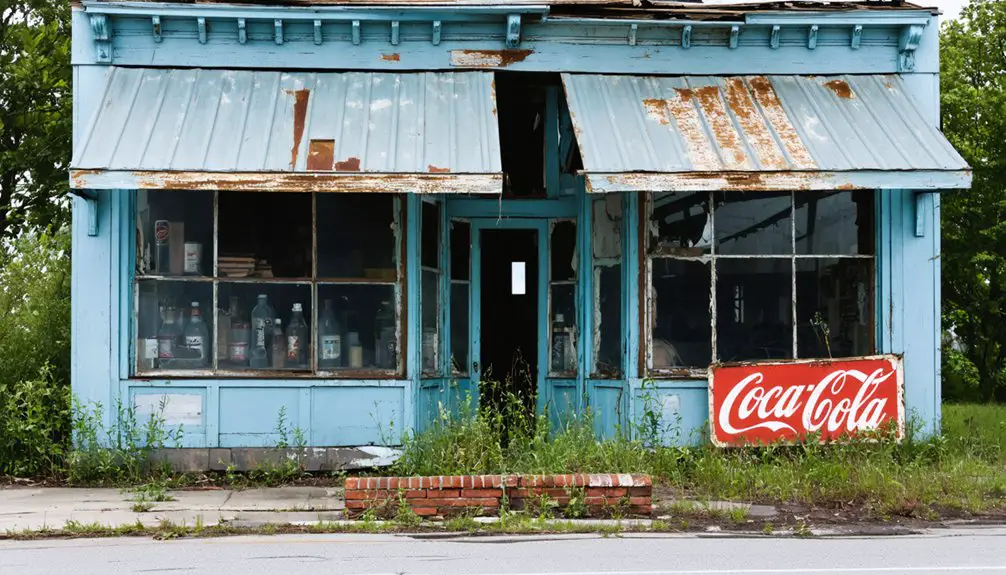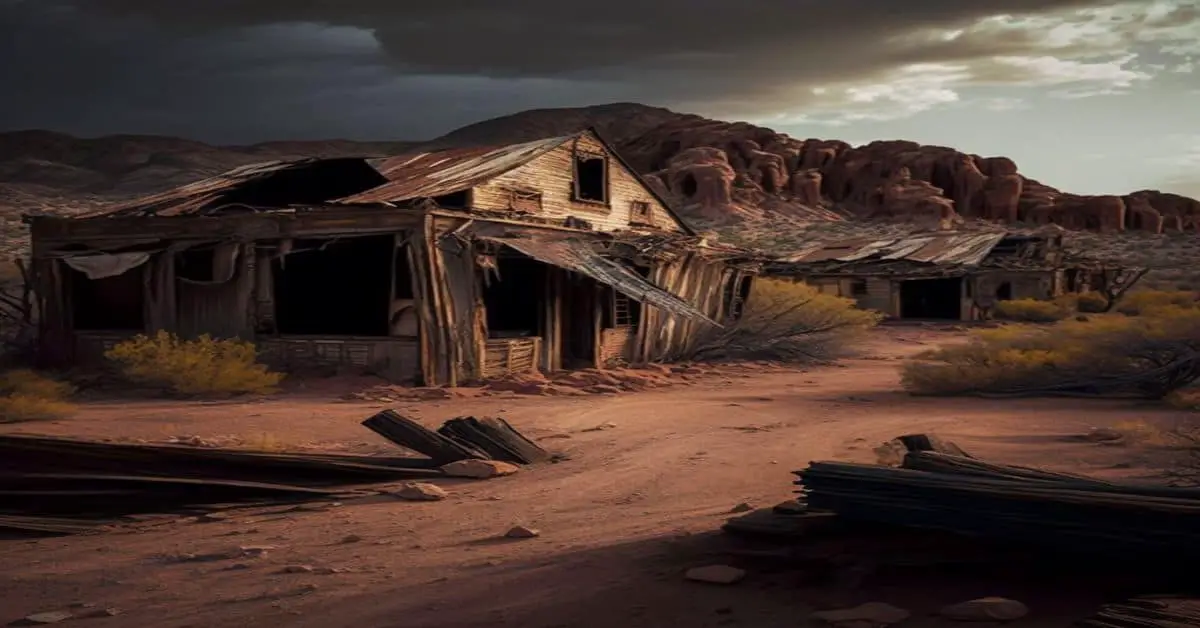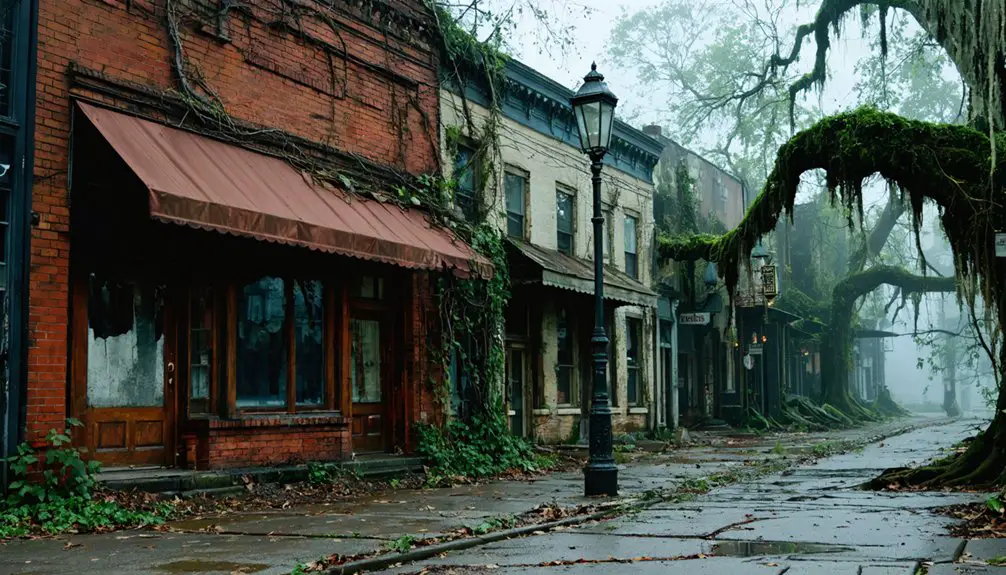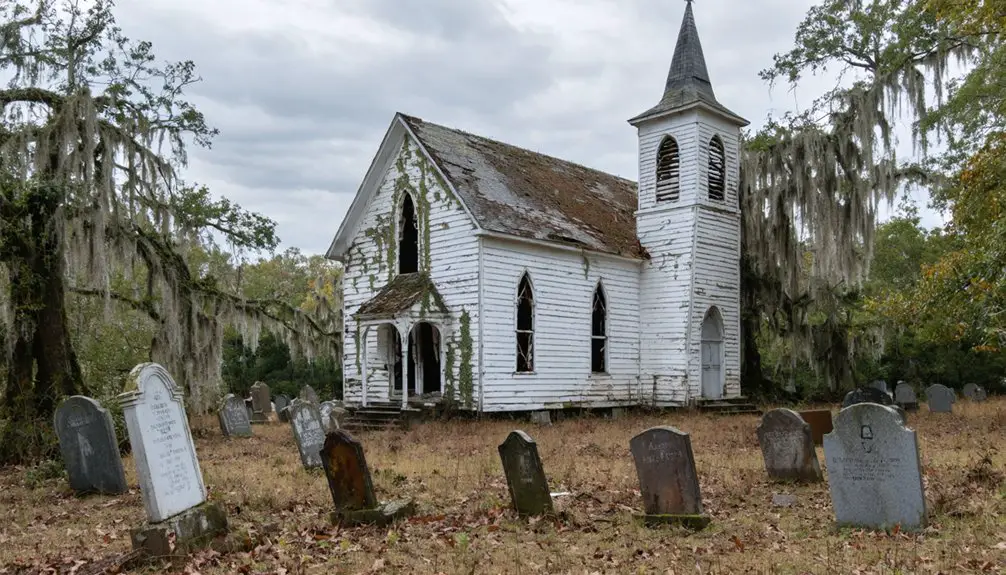You’ll find Newell’s ghost town remains in South Carolina, where it flourished as a ferry crossing settlement in the late 1700s before becoming a thriving commercial center. The town met its fate in 1950 when President Truman’s administration acquired 250,000 acres, including Newell, to build the Savannah River Plant for nuclear production. Today, abandoned structures and overgrown paths tell the story of 6,000 displaced residents and their lost community. The ruins hold countless untold stories of America’s Cold War sacrifice.
Key Takeaways
- Newell became a ghost town in 1950 when the U.S. government acquired 250,000 acres for the Savannah River Plant nuclear facility.
- The town’s 6,000 residents were forced to relocate through eminent domain, with many moving to nearby New Ellenton and Jackson.
- Physical remains include abandoned brick structures, partial wooden buildings, and original architectural elements like six-panel doors.
- The town’s history dates to the late 1700s, centered around Chappell’s ferry operations and later railroad-driven development.
- The site now features deteriorating infrastructure and overgrown pathways, with some areas only accessible by boat.
The Birth and Early Days of Newell
Although Newell’s early history is closely tied to the Chappell family’s ferry operations, the area’s settlement origins date back to the late 1700s when Thomas Chappell established the first commercial venture across the Saluda River.
You’ll find that early settlements near Newell grew around this essential crossing point, connecting Chappell’s land to the Culbreath Plantation.
While a bridge was initially built in 1792, its destruction in 1800 led to a return to ferry operations until John Chappell constructed a new bridge in 1838.
The community’s commercial footprint expanded with multiple stores and a post office opening in 1820.
The area saw significant growth with the arrival of the Greenville and Columbia Railroad in 1852, leading to increased trade and transportation opportunities.
Like many South Carolina communities, Newell relied heavily on plantation labor to sustain its agricultural economy during its early development.
You can trace the area’s significance through period maps, where it’s marked as “Chappell’s Ferry,” highlighting its role as an important river crossing in South Carolina’s early development.
Cold War Changes Everything: The Government’s Land Acquisition
When President Truman authorized the construction of the Savannah River Plant in 1950, Newell’s fate was forever altered.
You’d soon witness one of the most dramatic transformations in South Carolina’s history as the government acquired 250,000 acres of land, including Newell, through eminent domain. The Cold War’s nuclear strategy demanded a secure facility for plutonium and tritium production.
Government secrecy shrouded the entire operation as farmland gave way to a restricted industrial complex. Your farming neighbors were forced to relocate as the Atomic Energy Commission transformed the area into a high-security nuclear facility. DuPont Corporation was brought in to design and construct the massive complex. Today, the site continues its nuclear legacy with a MOX fuel plant under construction to convert weapons-grade plutonium into commercial reactor fuel.
The site’s selection wasn’t random – the Savannah River provided essential cooling for nuclear reactors while the rural location offered strategic isolation.
The peaceful agricultural community you once knew became part of America’s clandestine nuclear weapons program.
Life After Displacement: Community Impact and Memories
After the government’s acquisition of land, approximately 6,000 residents faced the stark reality of forced relocation from their homes near the Savannah River Plant.
While some found refuge in nearby towns like New Ellenton or Jackson, the displacement shattered established communities and livelihoods, sparking a profound economic transformation from agricultural to industrial work.
The mass relocation devastated rural life, forcing thousands to abandon farming traditions for factory jobs in unfamiliar surroundings.
The impact was particularly severe for African-American farmers and sharecroppers who lost both land and traditional income sources.
The government provided $19 million total in compensation for all land and property acquisitions, though this fell short of fair market values.
Community nostalgia remains strong through oral histories and photographs, though physical traces of these towns have largely vanished.
The trauma of displacement took its toll – more than half of Ellenton’s older residents who stayed in the region died within a decade.
Even today, the legacy of these lost communities lives on in the collective memory of displaced families and their descendants.
The town’s history began when it was established in 1880 as Ellenton, named after Ellen Dunbar whose father owned much of the surrounding land.
What Remains: Physical Legacy and Current Status
The physical remnants of Newell stand as silent witnesses to its former importance, with brick shells of businesses and partial wooden structures dotting the landscape.
You’ll find large timber beams still visible in abandoned houses, showcasing the craftsmanship of a bygone era. Several buildings still feature their original six-panel doors from construction. The town’s infrastructure tells its own story – old main street paths, while traceable, have surrendered to overgrowth and natural reclamation. Like many near-ghost towns, deteriorating buildings in the central business district reflect its historical significance.
Nature has reclaimed much of what humans left behind, with dense forest and fragrant wisteria wrapping around remaining structures.
Wildlife, particularly crows, now inhabit these abandoned spaces. While some decorative glass and durable materials have endured, most buildings continue to deteriorate without protection or restoration efforts, leaving only foundations and memories of this once-thriving community.
Newell’s Place in South Carolina’s Ghost Town History
Standing among South Carolina’s numerous ghost towns, Newell represents a classic example of nineteenth-century railroad-driven development and subsequent decline.
You’ll find that Newell’s ghost town dynamics mirror those of similar communities like Shelton and Ellenton, where initial prosperity tied to transportation routes and agricultural commerce gave way to eventual abandonment.
The historical significance of Newell lies in how it exemplifies the broader pattern of South Carolina’s lost communities. Some parts of the town, like at Lake Hartwell ruins, can now only be accessed by boat.
While some ghost towns in the state met dramatic ends through flooding or government acquisition, Newell’s story reflects the more common fade-to-obscurity narrative.
Like many of its contemporaries, the town succumbed to the combined pressures of declining cotton markets, shifting transportation patterns, and the irresistible pull of larger urban centers.
Frequently Asked Questions
Did Any Residents Refuse to Leave During the Government’s Forced Evacuation?
You won’t find documented cases of evacuation resistance in available resident testimonies. While emotional protest was evident through signs and oral histories, research shows people ultimately complied with government relocation orders.
What Specific Industries or Businesses Operated in Newell Before Its Abandonment?
Like threads in a tapestry, you’d find textile manufacturing dominated the local economy, alongside lumber production, sawmills, cotton gins, general stores, and rail-connected freight operations serving mill workers.
Are There Any Annual Gatherings or Reunions of Former Newell Residents?
You won’t find documented reunion events for former Newell residents. Historical records and community memories show no evidence of annual gatherings, unlike some other South Carolina ghost towns that maintain such traditions.
What Was the Average Property Value in Newell Before Government Acquisition?
Like a puzzle with missing pieces, you’ll find exact property values aren’t documented. Average market trends suggest values were likely lower than nearby areas’ $400,000 median, based on rural property sales patterns.
Were There Any Documented Paranormal Experiences After the Town’s Abandonment?
You won’t find any verified ghost sightings or paranormal investigations after Newell’s abandonment. Despite South Carolina’s rich supernatural history, there’s no documented evidence of supernatural activity in this specific location.
References
- https://strangetalespodcast.wordpress.com/2007/04/09/ellenton-sc-a-town-no-more/
- https://www.scetv.org/stories/2024/15-ghost-stories-south-carolina
- https://cityofdust.blogspot.com/2005/02/dead-towns-south-carolina.html
- https://sctravelguide.com/2018/06/11/south-carolina-ghost-towns/
- http://freepages.rootsweb.com/~gtusa/history/usa/sc.htm
- https://www.rootsandrecall.com/newberry/buildings/chappell-community-history/
- https://www.geotab.com/ghost-towns/
- https://www.randomconnections.com/ghost-towns-of-south-carolina/
- https://scdah.sc.gov/sites/scdah/files/Documents/Historic Preservation (SHPO)/Research/SRS_700-A-Area.pdf
- https://coldwarpatriots.org/a-legacy-savannah-river-site-the-product-of-decades-of-dedication-and-national-defense/



